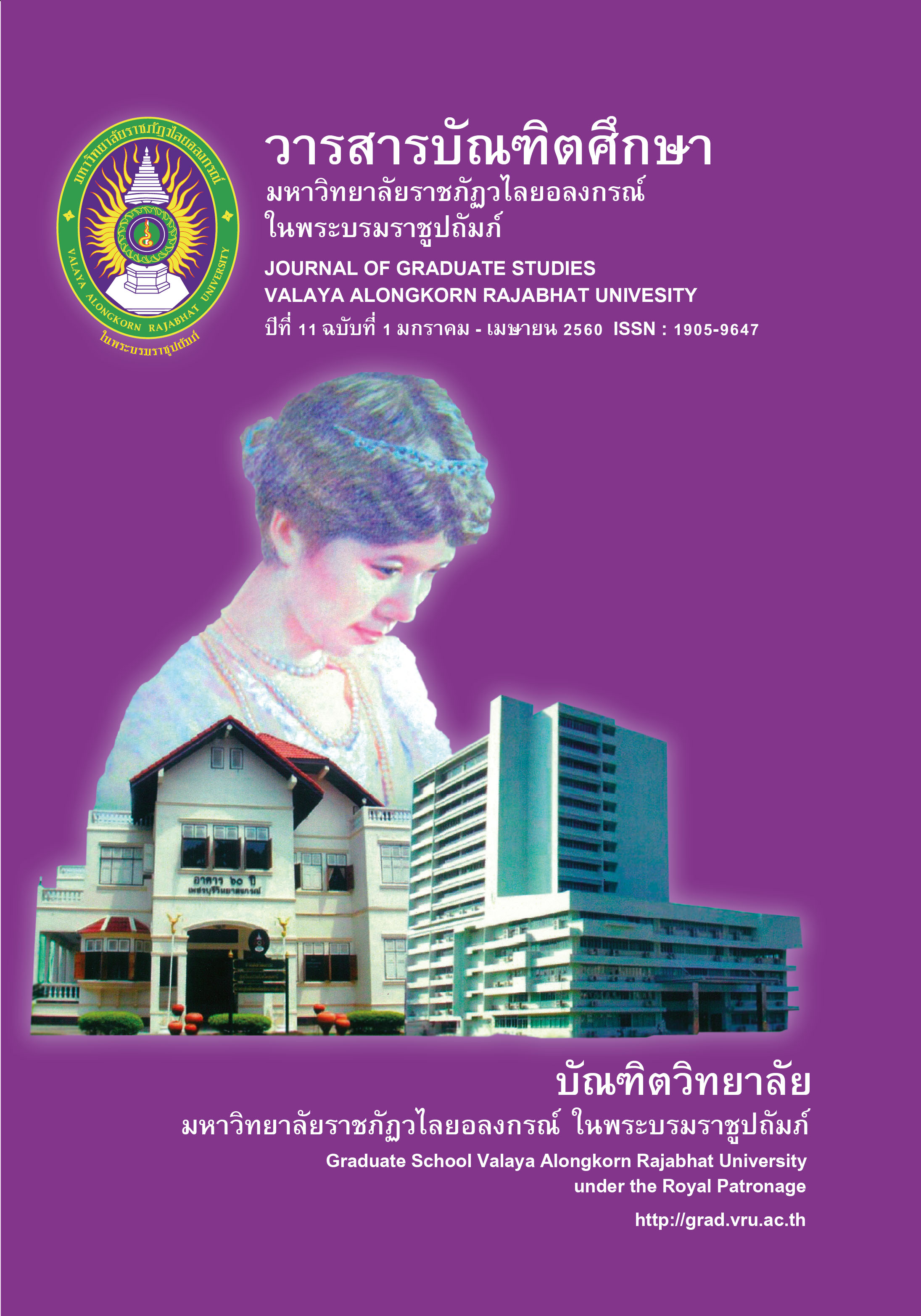ผลสัมฤทธิ์ทางการเรียนวิชาภาษาไทยเพื่อการสร้างสรรค์ และความพึงพอใจต่อวิธีการสอนแบบห้องเรียนกลับด้าน
Main Article Content
Abstract
บทคัดย่อ
การวิจัยครั้งนี้มีวัตถุประสงค์เพื่อเปรียบเทียบผลสัมฤทธิ์ทางการเรียนวิชาภาษาไทยเพื่อการสร้างสรรค์เรื่องการใช้คำ ชื่อเรื่อง ภาพพจน์ และโวหาร ของนักศึกษาที่ใช้วิธีการสอนแบบปกติและวิธีการสอนแบบห้องเรียนกลับด้าน และศึกษาความพึงพอใจต่อวิธีการสอนแบบห้องเรียนกลับด้าน โดยใช้รูปแบบการวิจัยเชิงทดลองกับนักศึกษาที่เรียนวิชาภาษาไทยเพื่อการสร้างสรรค์ ภาคการศึกษาที่ 1 ปีการศึกษา 2558 มหาวิทยาลัยกรุงเทพ ใช้วิธีการสุ่มตัวอย่างแบบแบ่งกลุ่มโดยจับสลากกลุ่มนักศึกษามา 2 กลุ่ม คือ กลุ่มควบคุมใช้วิธีการสอนแบบปกติจำนวน 66 คน และกลุ่มทดลองใช้วิธีการสอนแบบห้องเรียนกลับด้านจำนวน 74 คน เครื่องมือที่ใช้ในการวิจัยได้แก่ ชุดกิจกรรมการเรียนการสอน แบบทดสอบวัดผลสัมฤทธิ์ทางการเรียนวิชาภาษาไทยเพื่อการสร้างสรรค์ ซึ่งมีค่าความเชื่อมั่นของแบบทดสอบทั้งฉบับเท่ากับ 0.90 แบบสอบถามความพึงพอใจต่อวิธีการสอนแบบห้องเรียนกลับด้าน สถิติที่ใช้ในการวิจัย คือ ร้อยละ ค่าเฉลี่ย ส่วนเบี่ยงเบนมาตรฐาน สถิติทดสอบที การวิเคราะห์ความแปรปรวนร่วม
ผลการวิจัยพบว่า เมื่อมีการขจัดอิทธิพลของการเปรียบเทียบผลสัมฤทธิ์ทางการเรียนวิชา ภาษาไทยเพื่อการสร้างสรรค์ก่อนเรียน ผลการเปรียบเทียบผลสัมฤทธิ์ทางการเรียนของวิธีการสอนแบบปกติและวิธีการสอนแบบห้องเรียนกลับด้าน พบว่า ผลสัมฤทธิ์ทางการเรียนวิชาภาษาไทยเพื่อการสร้างสรรค์ จำนวน 3 เรื่อง ได้แก่ การใช้คำ ชื่อเรื่อง ภาพพจน์ หลังเรียนด้วยวิธีการสอนแบบห้องเรียนกลับด้านสูงกว่าวิธีการสอนแบบปกติอย่างมีนัยสำคัญที่ระดับ .05 ในขณะที่ผลสัมฤทธิ์ทางการเรียนเรื่องโวหารไม่แตกต่างกัน และผู้เรียนมีความพึงพอใจต่อวิธีการสอนแบบห้องเรียนกลับด้านทั้ง 3 ด้านในระดับมาก ได้แก่ ความพึงพอใจด้านความรู้ความเข้าใจเนื้อหา พบว่า การเตรียม พร้อมก่อนเรียนทำให้เวลาเรียนผู้เรียนมีความรู้ความเข้าใจมากขึ้น ด้านบรรยากาศการเรียน พบว่า ผู้เรียนมีความสุขและสนุกกับการเรียน และด้านการทำกิจกรรมกลุ่ม พบว่า กิจกรรมกลุ่มฝึกให้ผู้เรียนมีความสามัคคีและความรับผิดชอบร่วมกัน
ABSTRACT
This research aimed at comparing learning achievement on Thai Language for Creativity course in terms of word usage, titles, figures of speech and rhetoric between students who were taught with normal teaching method and those taught with the flipped classroom method and studying students’ satisfaction towards the flipped classroom method. The experimental study was conducted with Bangkok University students who studied Thai Language for Creativity course in the first semester of 2015 academic year. The samples comprised two groups of students gained from cluster sampling which were the control group of 66 students taught with the normal teaching method and the experimental group of 74 students taught with the flipped classroom method. Research instruments were sets of activity, a learning achievement test with the reliability coefficient of .90, and a questionnaire on satisfaction towards the flipped classroom method. Statistical methods used in this research were percentage, mean, standard deviation, t-test, and analysis of covariance: ANCOVA.
The results showed that when setting aside an influence of a comparison of learning achievement prior to learning, the learning achievement of students taught with the flipped classroom method was significantly higher than that of students taught with the normal teaching method at the .05 level covering 3 topics: word usage, titles, and figures of speech. However, no statistically significant difference was found in the students’ learning achievement in terms of rhetoric. In addition, the students were much satisfied with the flipped classroom method in three aspects. In terms of content comprehension, preparation before class enabled them to understand the content better. Regarding the class atmosphere, they had fun in learning. The group activities allowed them to be in harmony and have responsibilities in their study.
Article Details
บทความทุกเรื่องได้รับการตรวจความถูกต้องทางวิชาการโดยผู้ทรงคุณวุฒิ ทรรศนะและข้อคิดเห็นในบทความวารสารบัณฑิตศึกษา มหาวิทยาลัยราชภัฏวไลยอลงกรณ์ ในพระบรมราชูปถัมภ์ มิใช่เป็นทรรศนะและความคิดของผู้จัดทำจึงมิใช่ความรับผิดชอบของบัณฑิตวิทยาลัย มหาวิทยาลัยราชภัฏวไลยอลงกรณ์ ในพระบรมราชูปถัมภ์ กองบรรณาธิการไม่สงวนสิทธิ์การคัดลอก แต่ให้อ้างอิงแหล่งที่มา


